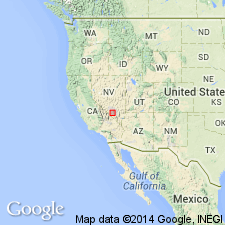
- Usage in publication:
-
- Calico Hills Formation*
- Modifications:
-
- Named
- Reference
- Geochronologic dating
- Dominant lithology:
-
- Tuff
- Lava
- AAPG geologic province:
-
- Great Basin province
Summary:
Named for Calico Hills, Topopah Spring quad, Nye Co, NV, Great Basin province. Type locality is on northwest side of Calico Hills; reference sections are drillholes USW G-2, interval 1701-2704 ft, at Yucca Mountain and UE-20f, interval 2954-4350 ft, at Pahute Mesa (fig. 1). Consists of sequences of rhyolite lava flows, domes, and nonwelded ash-flow and bedded tuffs. Maximum thickness is 4285 ft and is over 2000 ft thick in several drillholes in western Pahute Mesa; in Yucca Mountain area thickness ranges from 150-1000 ft. Consists of two stratigraphically and petrologically equivalent units previously referred to as tuffs and lavas of Calico Hills (significant in subsurface of Yucca Mountain) and tuffs and lavas of Area 20 (significant in subsurface of Pahute Mesa); units represent post-collapse volcanism associated with Crater Flat Group (rank raised). Occurs between underlying Wahmonie Formation (or Crater Flat Group where Wahmonie is absent) and overlying Paintbrush Group (rank raised). Nomenclature chart (table 1). 40Ar/39Ar age date on sanidine of 12.9 Ma (Miocene).
Source: GNU records (USGS DDS-6; Denver GNULEX).
For more information, please contact Nancy Stamm, Geologic Names Committee Secretary.
Asterisk (*) indicates published by U.S. Geological Survey authors.
"No current usage" (†) implies that a name has been abandoned or has fallen into disuse. Former usage and, if known, replacement name given in parentheses ( ).
Slash (/) indicates name conflicts with nomenclatural guidelines (CSN, 1933; ACSN, 1961, 1970; NACSN, 1983, 2005, 2021). May be explained within brackets ([ ]).

